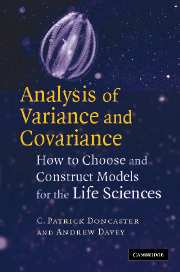Book contents
- Frontmatter
- Contents
- Preface
- Introduction to analysis of variance
- Introduction to model structures
- 1 One-factor designs
- 2 Nested designs
- 3 Fully replicated factorial designs
- 4 Randomised-block designs
- 5 Split-plot designs
- 6 Repeated-measures designs
- 7 Unreplicated designs
- Further Topics
- Choosing experimental designs
- How to request models in a statistics package
- Best practice in presentation of the design
- Troubleshooting problems during analysis
- Glossary
- References
- Index of all ANOVA models with up to three factors
- Index
- Categories of model
Troubleshooting problems during analysis
Published online by Cambridge University Press: 13 November 2009
- Frontmatter
- Contents
- Preface
- Introduction to analysis of variance
- Introduction to model structures
- 1 One-factor designs
- 2 Nested designs
- 3 Fully replicated factorial designs
- 4 Randomised-block designs
- 5 Split-plot designs
- 6 Repeated-measures designs
- 7 Unreplicated designs
- Further Topics
- Choosing experimental designs
- How to request models in a statistics package
- Best practice in presentation of the design
- Troubleshooting problems during analysis
- Glossary
- References
- Index of all ANOVA models with up to three factors
- Index
- Categories of model
Summary
Correctly identifying the appropriate model to use (see page 57) is the principal hurdle in any analysis, but running the chosen model in your favourite statistics package also presents a number of potential pitfalls. If you encounter problems when using a statistics package, do refer to its help routines and tutorials in order to understand the input requirements and output formats, and to help you interpret error messages. If that fails then look to see if you have encountered one of these common problems.
Problems with sampling design
If I just want to identify any differences amongst a suite of samples, can I do t tests on all sample pairs? No, the null hypothesis of no difference requires a single test yielding a single P-value. Multiple P-values are problematic in any unplanned probing of the data with more than one test of the same null hypothesis, because the repeated testing inflates the Type I error rate (illustrated by an example on page 252). If an ANOVA reveals a general difference between samples, explore where the significance lies using post hoc tests designed to account for the larger family-wise error (page 245).
- Type
- Chapter
- Information
- Analysis of Variance and CovarianceHow to Choose and Construct Models for the Life Sciences, pp. 264 - 270Publisher: Cambridge University PressPrint publication year: 2007



